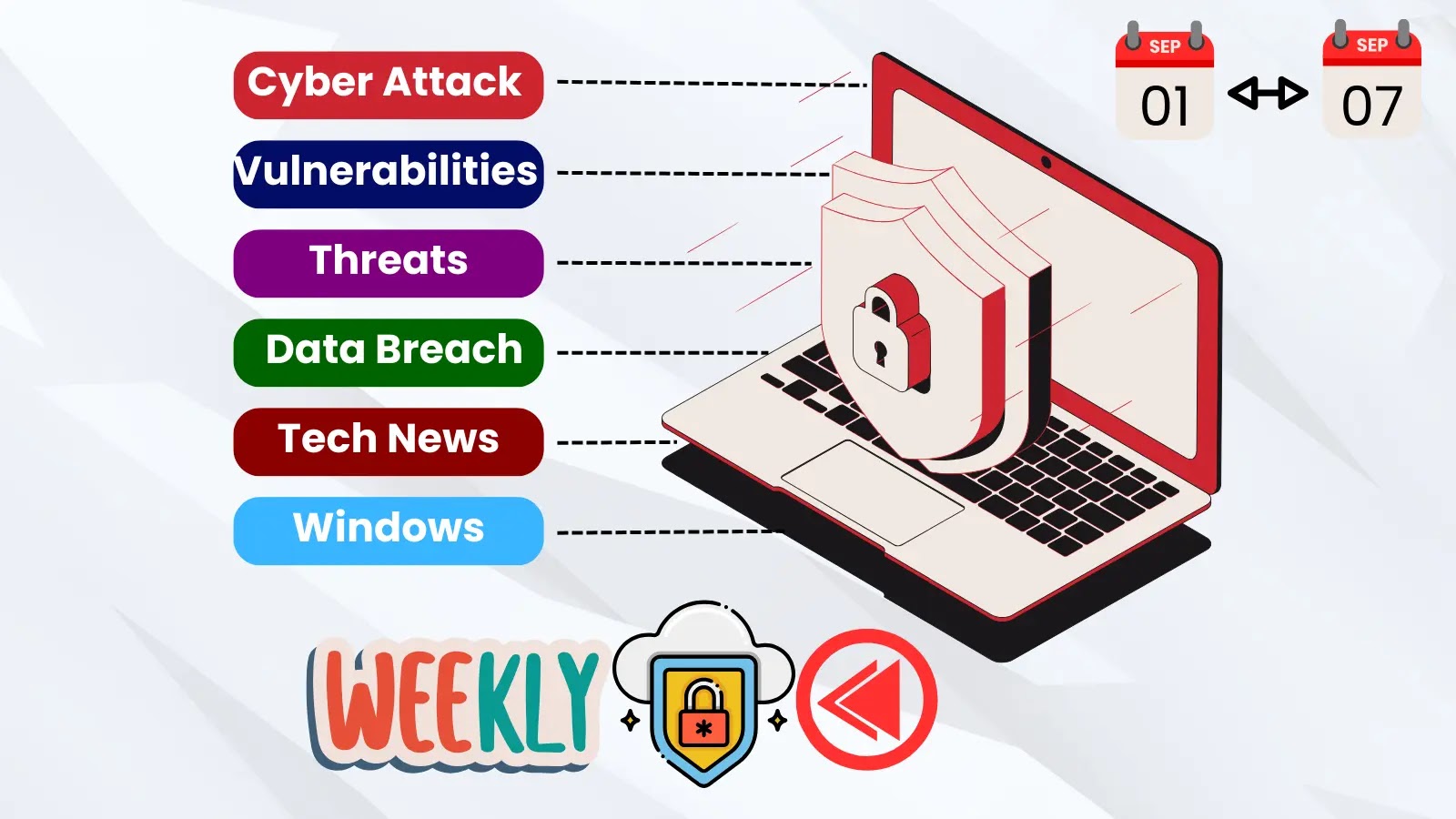In the ever-evolving landscape of cybersecurity, the past week has unveiled a series of critical vulnerabilities and sophisticated cyber attacks that underscore the importance of vigilance and prompt action. This comprehensive recap delves into the most pressing issues, providing insights and recommendations to bolster organizational defenses.
Vulnerabilities
1. Microsoft SharePoint Server Zero-Day Remote Code Execution (RCE) Exploit
The U.S. Cybersecurity and Infrastructure Security Agency (CISA) has recently added a critical zero-day vulnerability in Microsoft SharePoint Server to its Known Exploited Vulnerabilities catalog. Identified as CVE-2025-12345, this flaw permits unauthenticated remote code execution, potentially allowing attackers to compromise sensitive data or deploy malware on affected servers. Microsoft has released a patch in their latest security update, and organizations are strongly urged to apply it immediately to mitigate associated risks.
2. SS7 Protocol Bypass Attack Technique Unveiled
Security researchers have detailed a novel attack method that exploits the Signaling System 7 (SS7) protocol, a cornerstone in mobile networks for call routing and SMS delivery. This technique enables adversaries to intercept communications, spoof identities, or disrupt services by manipulating network signals. Telecom providers are advised to implement enhanced authentication and monitoring mechanisms to counter these threats, which have been observed in targeted espionage campaigns.
3. Active Exploitation of Cisco ISE RCE Vulnerabilities
Cisco has confirmed the active exploitation of multiple critical remote code execution flaws in its Identity Services Engine (ISE), including CVE-2025-20281, CVE-2025-20282, and CVE-2025-20337. These vulnerabilities allow unauthenticated attackers to execute arbitrary code with root privileges, potentially leading to full system compromise. Patches are available for ISE versions 3.3 and 3.4, and administrators should upgrade immediately to prevent unauthorized access.
4. Google Chrome’s V8 Engine Targeted by Type Confusion Attacks
A high-severity type confusion vulnerability (CVE-2024-12053) in Chrome’s V8 JavaScript engine has been exploited, allowing remote attackers to execute code via crafted web pages. This could result in data theft or malware installation. Google has addressed this issue in version 131.0.6778.108, and users should verify their browser is updated to avoid drive-by attacks.
5. Mozilla Releases Firefox 141 with Critical Vulnerability Fixes
Mozilla’s Firefox 141 update addresses 18 vulnerabilities, including high-impact memory safety bugs and flaws in JavaScript handling (e.g., CVE-2025-8027 and CVE-2025-8028). These could enable arbitrary code execution or privilege escalation on 64-bit systems. The release also patches moderate issues like sandbox bypasses. Users are encouraged to update their browsers promptly to secure their browsing experience.
6. SonicWall SMA 100 Series Vulnerable to Critical RCE Flaw
SonicWall has issued patches for a critical authenticated remote code execution vulnerability (CVE-2025-40599) in SMA 100 appliances, stemming from unrestricted file uploads. Attackers with administrative credentials could upload and execute malicious files. While this specific flaw has not yet been exploited, related attacks on SMA devices have been reported. Organizations should apply updates to versions 10.2.1.0-17sv or later to mitigate potential risks.
Cyber Attacks
1. Chinese Hackers Exploiting Ivanti VPN Vulnerability
A critical buffer overflow flaw (CVE-2025-22457) in Ivanti Connect Secure VPN appliances is being actively exploited by Chinese threat actors. The attackers deploy sophisticated malware like TRAILBLAZE and BRUSHFIRE to maintain persistence and evade detection. Organizations are urged to update to version 22.7R2.6 or later to protect their systems.
2. DarkCloud Stealer Targets Spanish Organizations
The DarkCloud information stealer is leveraging phishing emails with weaponized .TAR archives to target Spanish entities in technology, legal, financial, and government sectors. The malware harvests credentials, cryptocurrency wallets, and sensitive files while evading detection. Organizations should enhance their email security measures and educate employees on recognizing phishing attempts.
3. Qilin Ransomware Mimics ScreenConnect Login Pages
Qilin ransomware affiliates are using phishing campaigns to impersonate ScreenConnect login pages, bypassing multi-factor authentication protections and deploying ransomware across Managed Service Providers (MSPs) and their customers. This highlights the growing risks of supply chain attacks. Organizations should verify the authenticity of login pages and implement robust security protocols.
4. Russian Seashell Blizzard Intensifies Global Attacks
The Russian-linked Seashell Blizzard group has escalated its operations, targeting critical infrastructure sectors like energy and telecommunications worldwide. Their “BadPilot” campaign exploits software vulnerabilities to gain persistent access. Organizations in these sectors should conduct thorough security assessments and apply necessary patches to safeguard their systems.
5. Apache Tomcat Vulnerability Under Active Exploitation
A critical flaw (CVE-2025-24813) in Apache Tomcat allows attackers to take control of servers or steal sensitive data via malicious file uploads. Organizations using affected versions are advised to apply patches immediately to prevent potential breaches.
6. Over 1,500 PostgreSQL Servers Compromised
A fileless malware campaign has exploited misconfigured PostgreSQL instances globally, deploying cryptominers like XMRig-C3. The malware operates entirely in memory, making it difficult to detect. Administrators should review their PostgreSQL configurations and implement security best practices to prevent unauthorized access.
7. 20,000 WordPress Sites Vulnerable to File Upload Exploits
Two high-risk vulnerabilities in the WP Ultimate CSV Importer plugin (CVE-2025-2008 and CVE-2025-2007) allow attackers to upload malicious files or delete critical site files, leading to full site compromise. Website owners using this plugin should update to the latest version and monitor their sites for unusual activity.
Emerging Threats
1. White Snake Malware Updated with New Features
The notorious White Snake malware has received an update, introducing new features that enhance its capabilities. This malware is known for its ability to steal sensitive information from infected systems. The latest update includes improved evasion techniques, making it more challenging for traditional security measures to detect and mitigate its effects. Organizations should update their security tools and remain vigilant against this evolving threat.
2. GenAI-Generated Malware: A New Threat Landscape
The emergence of GenAI-generated malware marks a new era in cybersecurity threats. This type of malware is created using advanced generative AI techniques, allowing for the rapid development of unique and sophisticated malicious code. These AI-driven threats pose significant challenges to existing cybersecurity defenses due to their ability to evolve and adapt quickly. Security teams should invest in AI-driven defense mechanisms to counteract these advanced threats.
3. Octo2 Android Malware Targets Banking Credentials
A new strain of Android malware, dubbed Octo2, has been identified as a significant threat to mobile banking users. This malware is designed to steal banking credentials by overlaying legitimate banking apps with fake login screens. Users are urged to be vigilant and ensure their devices are protected with up-to-date security software. Financial institutions should also implement additional security measures to protect their customers.
4. LummaC2 Stealer: Custom Control Flow Execution
The LummaC2 stealer has been observed employing a custom control flow execution technique, making it harder for security solutions to detect its presence. This stealer targets sensitive data such as passwords and personal information, emphasizing the need for robust cybersecurity practices among users and organizations alike. Regular security audits and employee training can help mitigate the risks associated with such sophisticated malware.
5. SilentSelfie: Malicious Android App Exploit
The SilentSelfie exploit is a newly discovered vulnerability in certain Android applications that allows attackers to gain unauthorized access to device cameras without user consent. This exploit highlights the importance of regularly updating apps and operating systems to protect against such vulnerabilities. Users should be cautious about granting camera permissions and monitor their devices for unusual behavior.
Other Security News
1. CISA Releases Anonymized Threat Intelligence
The Cybersecurity and Infrastructure Security Agency (CISA) has released anonymized threat intelligence to help organizations bolster their cybersecurity defenses. This initiative aims to provide actionable insights without compromising the privacy of the data sources. The anonymized data can be used by security teams to identify and mitigate potential threats more effectively.
2. Cloudflare Launches Free Threat Intelligence Service
Cloudflare has announced a new free threat intelligence service designed to help organizations of all sizes enhance their security posture. This service provides real-time threat data, allowing businesses to stay ahead of potential cyber threats. By offering this service for free, Cloudflare aims to democratize access to critical security information.
3. CISA Issues Guidance on Industrial Control Systems Security
CISA has issued new guidance focused on improving the security of industrial control systems (ICS). This guidance is crucial for industries that rely heavily on ICS, such as energy and manufacturing, to protect against cyber threats that could disrupt operations and cause significant damage.
Conclusion
The cybersecurity landscape continues to evolve, presenting new challenges and threats to organizations worldwide. Staying informed about the latest vulnerabilities and attack vectors is crucial for maintaining robust security postures. Organizations are encouraged to apply patches promptly, educate employees on recognizing phishing attempts, and implement comprehensive security measures to protect against these emerging threats.



